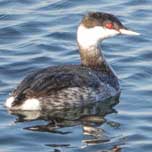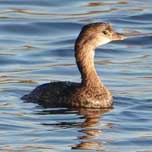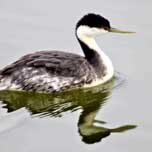Grebes are small to medium-large in size, have lobed toes, and are excellent swimmers and divers. Although they can run for a short distance, they are prone to falling over, since they have their feet placed far back on the body.
Grebes have narrow wings, and some species are reluctant to fly; indeed, two South American species are completely flightless. They respond to danger by diving rather than flying, and are in any case much less wary than ducks.
Grebes have unusual plumage. It is dense and waterproof, and on the underside the feathers are at right-angles to the skin, sticking straight out to begin with and curling at the tip. By pressing their feathers against the body, grebes can adjust their buoyancy. Often, they swim low in the water with just the head and neck exposed. They swim by simultaneously spreading out the feet and bring them inward with the webbing expanded to produce the forward thrust in much the same way as frogs.
In the non-breeding season, grebes are plain-colored in dark browns and whites. However, most have ornate and distinctive breeding plumages, often developing chestnut markings on the head area, and perform elaborate display rituals.
Grebes make floating nests of plant material concealed among reeds on the surface of the water. The young are precocial, and able to swim from birth.
The grebes are a radically distinct group of birds as regards their anatomy. Accordingly, they were at first believed to be related to the loons, which are also foot-propelled diving birds, and both families were once classified together under the order Colymbiformes. However, as recently as the 1930s, this was determined to be an example of convergent evolution by the strong selective forces encountered by unrelated birds sharing the same lifestyle at different times and in different habitat. Grebes and loons are now separately classified orders of Podicipediformes and Gaviiformes, respectively.
The cladistics vs. phenetics debate of the mid-20th century revived scientific interest in generalizing comparisons. As a consequence, the discredited grebe-loon link was discussed again. This even went as far as proposing monophyly for grebes, loons, and the toothed Hesperornithiformes.[6] In retrospect, the scientific value of the debate lies more in providing examples that a cladistic methodology is not incompatible with an overall phenetical scientific doctrine, and that thus, simply because some study "uses cladistics", it does not guarantee superior results.
Molecular studies such as DNA-DNA hybridization and sequence analyses fail to resolve the relationships of grebes properly due to insufficient resolution in the former and long-branch attraction in the latter. Still – actually because of this – they do confirm that these birds form a fairly ancient evolutionary lineage (or possibly one that was subject to selective pressures down to the molecular level even), and they support the non-relatedness of loons and grebes.
Many molecular and morphological studies support a relationship between grebes and flamingos.
Recent molecular studies have suggested a relation with flamingos, while morphological evidence also strongly supports a relationship between flamingos and grebes. They hold at least eleven morphological traits in common, which are not found in other birds. Many of these characteristics have been previously identified in flamingos, but not in grebes.

ComingsBirds.com
to the beauty of birds

- Home California Birds
- SLIDESHOW
- SUMMARY OF ALL BIRDS
- MOVIES
- American Avocet
- American Coot
- Blackbirds/Crows
- Blue-grey gnatcatcher
- Brant
- Brown Pelican
- Chickade Mountain
- Comings' Backyard
- Common Loon
- Curlew Long-billed
- Dowitcher Long-billed
- Dowitcher Short-billed
- DUCKS
- EGRETS
- Dunlin
- Godwit Marbled
- Goldfinch Lesser
- GREBES
- Gnatcatcher Blue-grey
- Grosbeak Black-headed
- Gull California
- HUMMINGBIRDS
- Gull Heermann's
- Heron Black-crowned
- Heron Great Blue
- House Finch
- Jays
- Killdeer
- Merganser Red-breasted
- Nutcracker Clark's
- NutmegMannikin.com
- Other Birds
- Phainopepla
- Phoebe Say's
- Plover Black-bellied
- Plover Western Snowy
- Quail California
- Kittywake Black-legged
- Recent Additions
- Roadrunner Greater
- Sandpiper Least
- Sandpiper Western
- Sally's Fish
- Sanderling
- Shore Birds Other
- Skimmer Black
- Sparrow White-crowned
- Song Sparrow
- Stilt Black-necked
- Surf Scoter
- Swallow Tree
- Teal Blue-winged
- Teal Green-Winged
- Teal Cinnamon
- Tern Common
- Tern Elegant
- Turnstone Black
- Turnstone Ruddy
- Western Meadowlark
- Whimbrel
- Willet
- Yellow Leggs
- WOODPECKERS
- Template
- Contact Me



© 2009 David Comings Contact Me